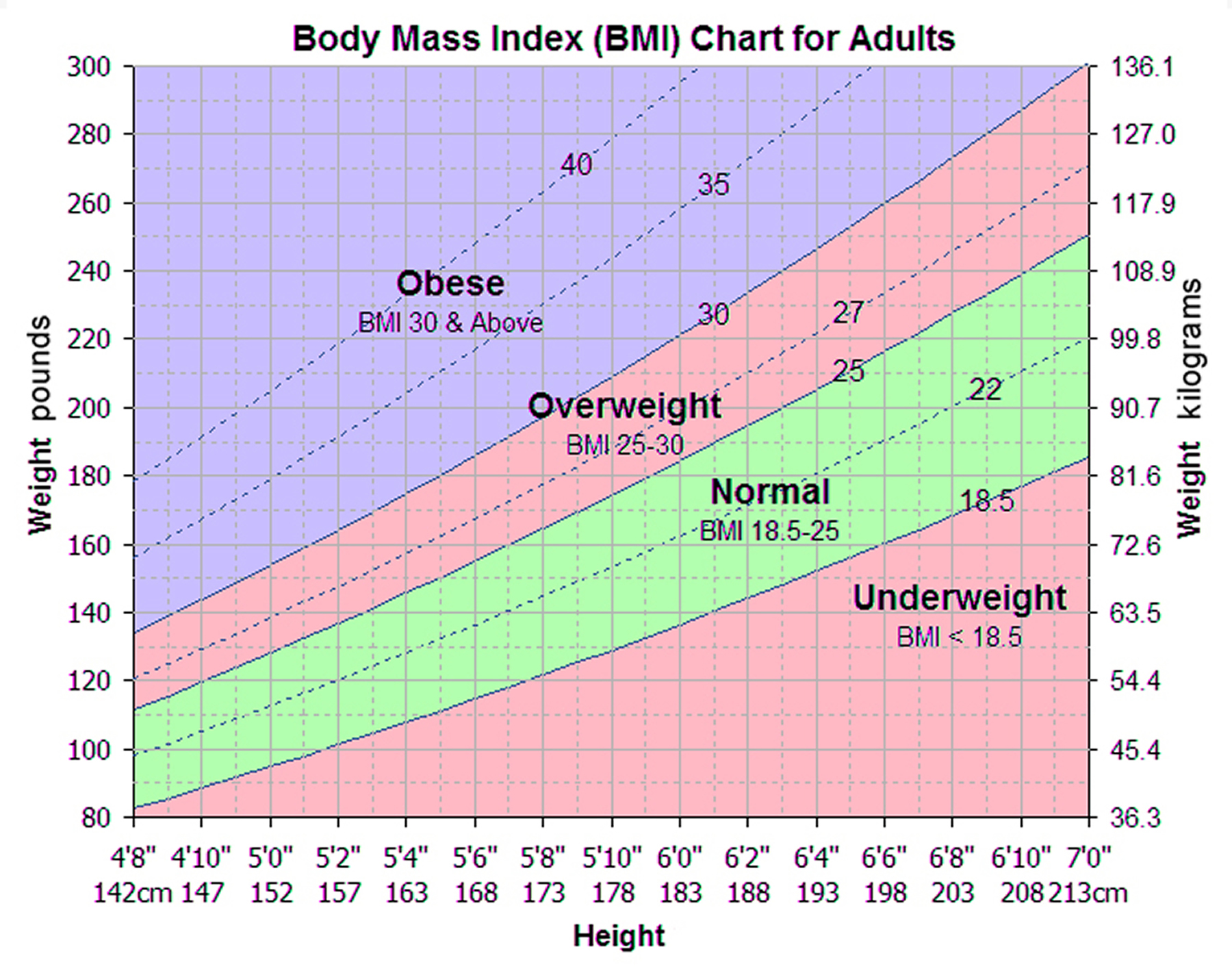Body Mass Index
The body mass index (BMI) or Quetelet index is a value derived from the mass (weight) and height of an individual. The body mass index (BMI) is defined as the body mass divided by the square of the body height, and is universally expressed in units of kg/m2, resulting from mass in kilograms and height in meters.
BMI is considered an important measure for understanding population trends. For individuals, it is one of many factors that should be considered in evaluating healthy weight, along with waist size, body fat composition, waist circumference, blood pressure, cholesterol level and blood sugar.
The World Health Organization defines overweight as a body mass index equal to or more than 25 – 29.9 kg/m2 and obesity as a BMI equal to or more than 30.
Adults with a body mass index of 35 or higher and an obesity-related condition (e.g., diabetes) and adults with a BMI of 40 kg/m2 or higher are considered severely obese.
Moreover, your Body Mass Index (BMI) does not take into account your age, gender or muscle mass. Nor does it distinguish between lean body mass and fat mass. As a result, some people, such as heavily muscled athletes, may have a high BMI even though they don’t have a high percentage of body fat. In others, such as elderly people, body mass index may appear normal even though muscle has been lost with aging.
To calculate your body mass index, you divide your body weight in kilograms by your height in meter squared (commonly expressed as kg/m2), see the body mass index formula below.
To find out about your body mass index (BMI), you can use a FREE online BMI calculators from the Centers for Disease Control and Prevention (CDC) :
- Adults (https://www.cdc.gov/healthyweight/assessing/bmi/adult_BMI/english_bmi_calculator/bmi_calculator.html)
For children and adolescents (younger than 20 years of age), overweight and obesity are based on the Centers for Disease Control and Prevention’s (CDC’s) BMI-for-age growth charts, which are available at (https://www.cdc.gov/growthcharts/clinical_charts.htm).
The CDC has a BMI percentile calculator for children and teens at 1.
Body Mass Index for Men and Women Adults
The body mass index is an attempt to quantify the amount of tissue mass (muscle, fat, and bone) in an individual, and then categorize that person as underweight, normal weight, overweight, or obese based on that value. Commonly accepted body mass index ranges are:
- A) Underweight: under 18.5 kg/m2
- B) Normal weight: 18.5 to 25 kg/m2
- C) Overweight: 25 to 30 kg/m2
- D) Obese: over 30 to 39.9 kg/m2
- E) Severely Obese: over 40 kg/m2
Two thirds of the adult population in the United States and at least half the populations of many other developed countries are currently overweight or obese 2. Although it is well established that obese people — defined as having a body-mass index (BMI) (the weight in kilograms divided by the square of the height in meters) of 30.0 kg/m2 or more — have increased death rates from heart disease, stroke, and many specific cancers 3. In this large, pooled analysis of prospective studies, both overweight and obesity (and possibly underweight BMI below 22·5 kg/m2) were associated with increased all-cause mortality in analyses restricted to participants who never smoked and did not have diagnosed cancer or heart disease 4. Although other anthropometric measures (eg, waist circumference, waist-to-hip ratio) could well add extra information to the body-mass index (BMI), and BMI to them, body-mass index (BMI) is in itself a strong predictor of overall mortality both above and below the apparent optimum of about 22·5–25 kg/m2. The progressive excess mortality above this range is due mainly to vascular disease and is probably largely causal. At 30–35 kg/m2, median survival is reduced by 2–4 years; at 40–45 kg/m2, it is reduced by 8–10 years (which is comparable with the effects of smoking) 5.
People of Asian descent have different associations between body mass index, percentage of body fat, and health risks than those of European descent, with a higher risk of type 2 diabetes and cardiovascular disease at body mass index lower than the WHO cut-off point for overweight, 25 kg/m2, although the cutoff for observed risk varies among different Asian populations.
Essentially, body mass index is a simple mathematical formula, based on height and weight, that is used to measure fatness. You should be aware of your BMI because of the health risks of being overweight (that is, having a BMI of 25 or over). According to a report in the August 2006 New England Journal of Medicine, excess body weight during midlife is associated with an increased risk of death.
While BMI is a simple, inexpensive method of screening for weight categories, it is not a diagnostic tool. BMI provides the most useful population-level measure of overweight and obesity as it is the same for both sexes and for all ages of adults. However, it should be considered a rough guide because it may not correspond to the same degree of fatness in different individuals. Measuring BMI while it is a simple, inexpensive method of screening for weight categories, it is not a diagnostic tool. Health professionals use other tools to do further assessments to fully evaluate health risks. These additional tools would include measurements of waist hip ratio, body fat percentage, diet history, exercise patterns, and family history. One thing that experts agree on is that weight is only one factor in our risk for disease. When it comes to evaluating weight and its impact on health, your percentage of body fat, waist circumference, BMI, and physical activity patterns are all important.
Furthermore, BMI does not take into account your age, gender or muscle mass. Nor does it distinguish between lean body mass and fat mass. As a result, some people, such as heavily muscled athletes, may have a high BMI even though they don’t have a high percentage of body fat. In others, such as elderly people, BMI may appear normal even though muscle has been lost with aging.
Fat around your waist is more biologically active and can do more damage to your body than weight around your hips. The research data show that waist circumference is more reliable and more closely correlated with diseases associated with obesity.
In people who are not overweight, waist size may be an even more telling warning sign of increased health risks than BMI 6. An expert panel convened by the National Institutes of Health identified these useful benchmarks: Men should aim for a waist size below 40 inches (102 cm) and women should aim for a waist size below 35 inches (88 cm) 7.
According to the National Institutes of Health, a bigger waist circumference (greater than 40 inches for men and 35 inches for women) is linked to a higher risk of type 2 diabetes, high blood pressure, abnormal cholesterol levels, and heart disease when BMI is 25 to 34.9 kg/m2 7.
- Although BMI can be used for most men and women, it does have some limitations. It may overestimate body fat in athletes and others who have a muscular build. BMI also may underestimate body fat in older people and others who have lost muscle.
Furthermore, the fat around your waist is more biologically active and can do more damage to your body than weight around your hips. The research data show that waist circumference is more reliable and more closely correlated with diseases associated with obesity.
Many health care experts think BMI is a useful tool to measure weight and health risks, but others question its accuracy. Some believe a better way might be to take out the tape measure and check your waist circumference (the waist hip ratio). This is because your health is not only affected by excess body fat, but also by where the fat is located. Some people gain weight in their abdominal regions (the so-called ”apple” body shape.) Others are ”pear-shaped,” with excess weight around the hips and buttocks. People with apple shapes are at higher risk for health problems associated with being overweight.
According to the National Institutes of Health, a bigger waist circumference (greater than 40 inches for men and 35 inches for women) is linked to a higher risk of type 2 diabetes, high blood pressure, abnormal cholesterol levels, and heart disease when BMI is 25 to 34.9 kg/m2.
One thing that experts agree on is that weight is only one factor in your risk for disease. When it comes to evaluating weight and its impact on health, your percentage of body fat, waist circumference, BMI, and physical activity patterns are all important.
The National Heart, Lung, and Blood Institute recommends that health care providers assess BMI, waist circumference, and any other risk factors for obesity-related conditions. Combining all of the information provides the best assessment.
Body Mass Index for Children and Teens
Overweight are obesity are defined differently for children and teens than for adults. Children are still growing, and boys and girls mature at different rates.
BMIs for children and teens compare their heights and weights against growth charts that take age and sex into account. This is called BMI-for-age percentile. A child or teen’s BMI-for-age percentile shows how his or her BMI compares with other boys and girls of the same age.
For children, age needs to be considered when defining overweight and obesity.
For children under 5 years of age:
- overweight is weight-for-height greater than 2 standard deviations above WHO Child Growth Standards median; and
- obesity is weight-for-height greater than 3 standard deviations above the WHO Child Growth Standards median.
Children aged between 5–19 years
Overweight and obesity are defined as follows for children aged between 5–19 years:
- overweight is BMI-for-age greater than 1 standard deviation above the WHO Growth Reference median; and
- obesity is greater than 2 standard deviations above the WHO Growth Reference median.
What Does the BMI-for-Age Percentile Mean ?
BMI-for-Age Percentile
Less than 5th percentile = Underweight
5th percentile to less than the 85th percentile = Healthy weight
85th percentile to less than the 95th percentile = Risk of overweight
95th percentile or greater =Overweight
For more information about BMI-for-age and growth charts for children, go to the Centers for Disease Control and Prevention’s BMI-for-age calculator.
References- Centers for Disease Control and Prevention. BMI Percentile Calculator for Child and Teen. https://www.cdc.gov/healthyweight/bmi/calculator.html
- Ogden CL, Carroll MD, Curtin LR, et al. Prevalence of overweight and obesity in the United States, 1999–2004. JAMA. 2006;295:1549–1555. https://www.ncbi.nlm.nih.gov/pubmed/16595758
- Prospective Studies Collaboration. Body-mass index and cause-specific mortality in 900 000 adults: collaborative analyses of 57 prospective studies. Lancet. 2009;373:1083–1096. https://www.ncbi.nlm.nih.gov/pmc/articles/PMC2662372/
- De Gonzalez AB, Hartge P, Cerhan JR, et al. Body-Mass Index and Mortality among 1.46 Million White Adults. The New England journal of medicine. 2010;363(23):2211-2219. doi:10.1056/NEJMoa1000367. https://www.ncbi.nlm.nih.gov/pmc/articles/PMC3066051/
- Prospective Studies Collaboration. Body-mass index and cause-specific mortality in 900 000 adults: collaborative analyses of 57 prospective studies. Lancet. 2009;373(9669):1083-1096. doi:10.1016/S0140-6736(09)60318-4. https://www.ncbi.nlm.nih.gov/pmc/articles/PMC2662372/
- Zhang C, Rexrode KM, van Dam RM, Li TY, Hu FB. Abdominal obesity and the risk of all-cause, cardiovascular, and cancer mortality: sixteen years of follow-up in US women. Circulation. 2008;117:1658-67. http://circ.ahajournals.org/content/117/13/1658.long
- National Heart, Lung, and Blood Institute. Clinical guidelines on the identification, evaluation, and treatment of overweight and obesity in adults: the evidence report. Bethesda, MD; 1998. https://www.nhlbi.nih.gov/health/health-topics/topics/obe









